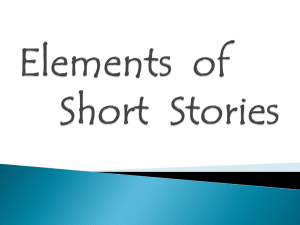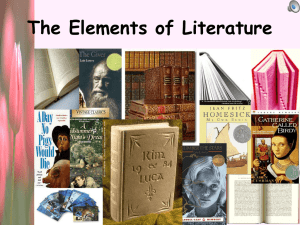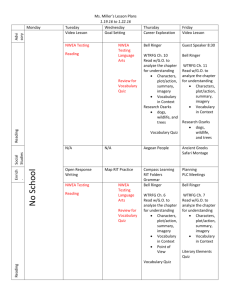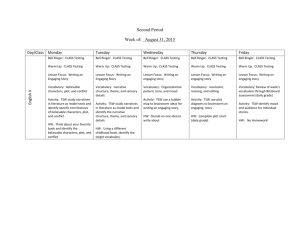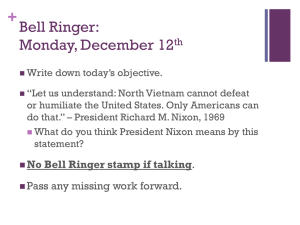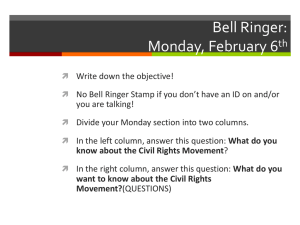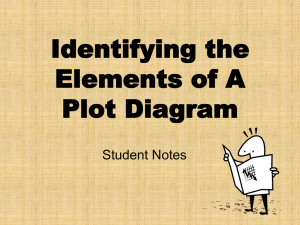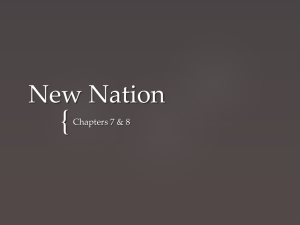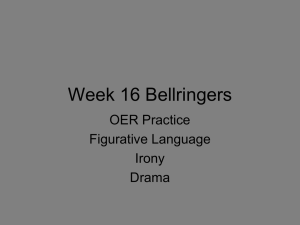INTERLOPERS BY SAKI
advertisement
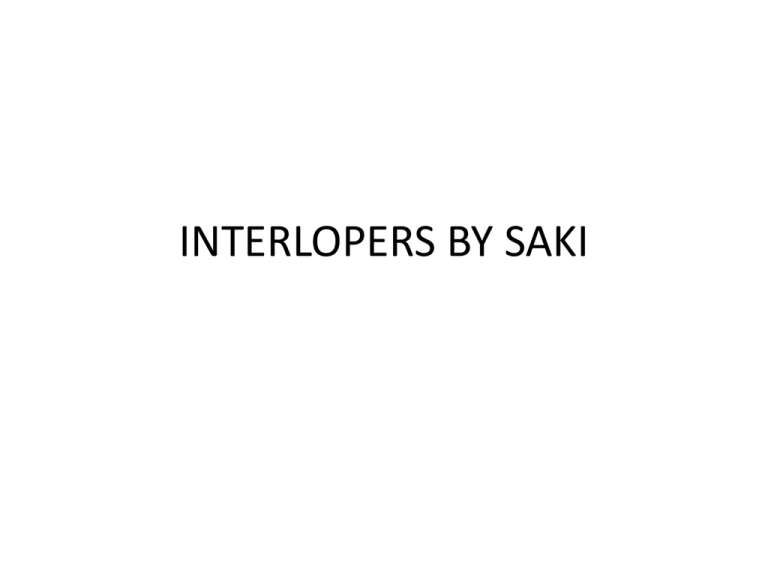
INTERLOPERS BY SAKI BELL RINGER • Identify if you agree or disagree with the statement on the butcher paper on the board. • Use the stickers to make your vote. • Make sure you answer all 6. • We will discuss as a class when everyone has voted. Organize your folder! • • • • • • • • • • • Bell Ringer: Parallel Structure Bell Ringer: Values Survey (2 sheets) Story Tag Bell Ringer: Theme Free Write (Wealth/Pride/Sacrifice/Love) Bell Ringer: 4 Famous Quotes - Quote Sandwich Bell Ringer handout: Paragraph Brainstorming “The Necklace” Plot Comic Strip (not 4A) “The Necklace” worksheet Notes: Quote Sandwich Quote Sandwich handout “The Gift of the Magi” worksheet • Serious arguments can begin with trivial matters. • People who quarrel for along time often forget why they started fighting in the first place. • Arguments always weaken over time. • When arguing you should never show weakness. • If you apologize first , it shows you are wrong. • Revenge is the best way to settle an argument. Literary Conflict Conflict • In a story, conflict is the struggle between opposing forces. Protagonist The main character Antagonist The character in conflict with the main character External External Conflict takes place outside of the body External There are three types of external conflict Man vs. Man The struggle is between two or more characters in the story. External Man vs. Nature This type of conflict pits a story's main character or characters against a natural force such as a flood, predatory animal, or disease epidemic. External Man Against Society In many stories, the protagonist battles against element of government or culture. Internal Internal Conflict takes place inside of the body/mind. Internal • There is one type of internal conflict. Man vs. Self The struggle or opposition is within one character--making a tough decision, for example. A character struggling to overcome fear, addiction, emotional damage or other crippling personal issue. Internal Man vs. Self Some literary conflicts take the form of a character struggling to overcome fear, addiction, emotional damage or other crippling personal issue. Practice Decide what type of conflict is being illustrated in the following pictures 1. Man vs. ? Answer: • MAN VS NATURE 2. Man vs. ? Answer: • MAN VS SELF 3. Man vs. ? ANSWER: • MAN VS MAN 4. Man vs. ANSWER: • MAN VS SOCIETY 5. Man vs. ? ANSWER: • MAN VS NATURE 6. Man vs. ? ANSWER: • MAN VS SOCIETY 7. Man vs. ? ANSWER: • MAN VS MAN Practice Now that you have mastered pictures, let’s try some text! 8. Man vs. ? “If she had only proceeded more slowly. If she had only taken the Southerly route, avoiding the icebergs. If only the watch had had a pair of binoculars.” (news story about the Titanic) ANSWER: • MAN VS NATURE 9. Man vs. ? Charles decided to break all the rules the day he decided to steal that car. He was immediately arrested and sent to jail to await his trial. He should have known better than to mess with the “rules.” ANSWER: • MAN VS SOCIETY 10. Man vs. ? “I don’t care who you talk to!” screamed Sarah to Wes. “I just wish I had never met you!” ANSWER: • MAN VS MAN 11. Man vs. ? After the light in the cave was completely gone Tom began to stumble through the cave blindly cutting his hands on what appeared to be sharp rocks. ANSWER: • MAN VS NATURE 12. Man vs. ? Tom found a dry spot to sit down in the dark and began to feel guilty over an argument he had had earlier in the day with his mother in which he had said, “I hope I never see you again!” ANSWER: • MAN VS SELF 13. Man vs. ? Tom’s mother was upset that he wanted to skip going to college in order to go exploring in all of the world’s greatest caves before he turned thirty. Tom didn’t understand what the big deal was and wanted to run his own life. ANSWER: • MAN VS MAN Keep the Question Going • Have one student give an example of Man vs Man, Man vs Self, Man vs Society, or Man vs. Nature. Then have another student explain why or why not it is a good example. READ and LISTEN • Interlopers page 262 https://play.google.com/music/listen#/now Denouement is simply the very end of the story. The difference between the Climax and the Denouement • The climax is when the guy gets the girl or the car chase that catches the villain. • The denouement, on the other hand, is the short scene after the climax where things get clarified and all the loose ends are tied up. Individual Work Time • TASKS – 1. Work on Annotations – 2. Indirect Characterization- You may choose either main characters. – 3. Identify the value – 4. Finish Vocabulary Closure- Point of View • When an author writes in third person omniscient, the audience is able to _________ and _________ everything about each character. Because of this, we are able to see into the __________ of multiple characters and create a _________ relationship and ________ with them. We are also able to see the __________of multiple characters, which will help us ___________the plot of the story. • When an author writes in third person omniscient, the audience is able to know and see everything about each character. Because of this, we are able to see into the _______ of multiple characters and create a____________ relationship and ________with them. We are also able to see the _________ of multiple characters, which will help us ___________ the plot of the story. • When an author writes in third person omniscient, the audience is able to know and see everything about each character. Because of this, we are able to see into the minds of multiple characters and create a _________ relationship and ________ with them. We are also able to see the ________ of multiple characters, which will help us ___________ the plot of the story. • When an author writes in third person omniscient, the audience is able to know and see everything about each character. Because of this, we are able to see into the minds of multiple characters and create a stronger relationship and bond with them. We are also able to see the _________of multiple characters, which will help us ____________ the plot of the story. • When an author writes in third person omniscient, the audience is able to know and see everything about each character. Because of this, we are able to see into the minds of multiple characters and create a stronger relationship and bond with them. We are also able to see the reaction of multiple characters, which will help us interpret the plot of the story. Closure • Do you think the author used the Omniscient Narrator effectively? Do you think it is easier to address the conflict of the major character when using this particular point of view? Why or Why not?
